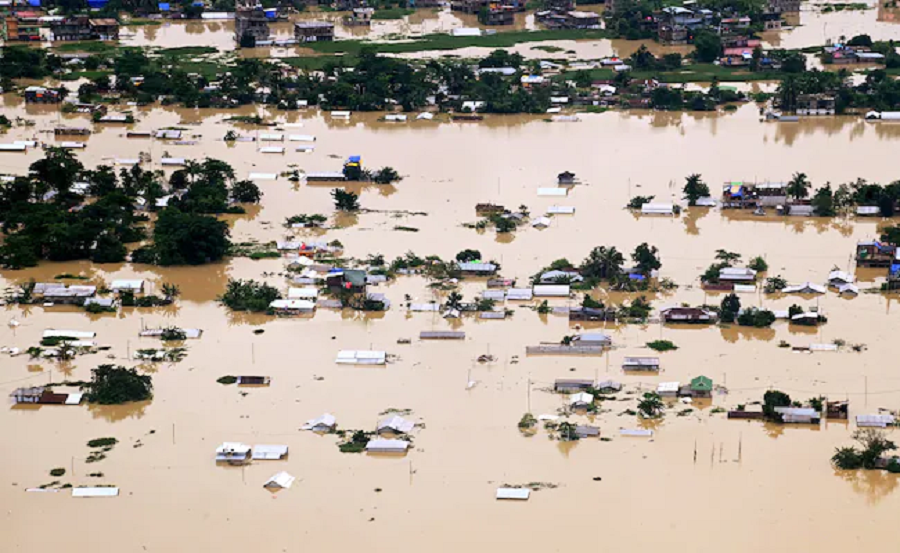There is a popular question often thrown at participants during quiz competitions in Assam – how many districts in Assam get flooded? Those who have faced this know that this is a tricky one. Since the number of districts keeps increasing every year, it is difficult to keep track of the exact boundaries or the total number. Therefore a very safe answer is “all districts”, which also happens to be a correct answer and a precise one that too.
Just like seasons – spring, autumn, winter, floods are a yearly occurrence in Assam. Every year they claim thousands of lives, ravage countless villages and towns, destroy public and private property worth crores; in short, they are a bane of Assam. Here one may wonder if these floods have been the architects of Assam’s current landscape. However, that question can wait for another time. Instead, let us explore the flood control measures deployed over the years to mitigate the impact. Have they truly been effective? And can we envision an Assam where floods persist, yet suffering becomes a thing of the past?
The flood issue in Assam is not merely an environmental disaster but a hybrid of human-environment artefact if seen through the lens of a political ecology framework, as rightly proposed by Gilbert F. White in his paper “Human Adjustment to Floods: a Geographical Approach to the Flood Problem in the United States in 1945”. For a discerning observer, there would be four thesis of political ecology about recurrence of floods in Assam and the consequent mayhem
Beyond nature’s wrath
One glaring lapse is the lack of coordination between the state and the Centre. Flood control in Assam appears more as a knee-jerk reaction rather than a well-prepared strategy. Moreover, the response time is alarmingly slow. Often, the immediate reaction involves constructing embankments without addressing the issue of soil erosion, leading to severe consequences. The 2013 flood report by the Assam State Disaster Management Authority (ASDMA) highlighted breaches in Brahmajan and Solengi River embankments in Gohpur due to negligence in implementing essential river-protection measures post-embankment construction, which cost Rs 5 crore.
Regrettably, more than half of the embankments remain in a perilous state for most of the year, perpetuating a “recurring floods” phenomenon. The root cause lies in the nexus between contractors and the administration, reaping seasonal benefits from flood situations.
When conservation goes wrong
While conservation efforts to protect the environment are well-intentioned, they can inadvertently contribute to the flood woes in Assam. Cordial attempts at flood control, such as building embankments and dams, often have unintended consequences that harm the environment in the long run, exacerbating the flood situation.
An illustrative example is the Ranganadi Hydroelectric Plant, commissioned by the North East Electrical Power Corporation (NEEPCO) in the Yazali district of Arunachal Pradesh in 2001. Despite its benefits, this dam has proven to be a significant headache for the people of Lakhimpur and Dhemaji districts in Assam. When NEEPCO releases water from the dam, it takes merely three hours to reach North Lakhimpur, causing a sudden and torrential inflow that inundates several villages along the banks of the Ranganadi River.
Likewise, Golaghat in Upper Assam has faced similar challenges since 2000 due to another NEEPCO dam on the Doyang River, which flows through Nagaland and Assam. In an unintended consequence, certain environmental victims have emerged, pushing communities to the edge of their endurance. It becomes evident that flood-control measures of this kind have created a class of people who bear the brunt of these projects, suffering from their unintended repercussions.
Low-income farmers bear the brunt
Floods, a natural disaster, do not affect everyone equally. Among those most vulnerable are the low-income households heavily reliant on agriculture. Residing in remote locations amid nature’s lap, these communities face disproportionate impacts from floods and other hazards.
For populations dependent on agriculture, livestock, and fishing, annual floods often lead to the abandonment of lands and homes. Seeking livelihood opportunities, many migrate to cities, leaving behind an older generation and a dwindling number of farmers capable of sustaining agricultural output.
In the flood-prone region of the Brahmaputra plains, a complex interplay between cultivation, production, degradation, and marginalisation emerges. As floods compel people to flee regions of Assam, families, friends, and identities are fragmented, exacerbating the out-migration trend in the state.
However, amidst the flood chaos, another marginalised group, the char-dwellers, grapple with the annual floods. Known as “chars”, these sandbars are alluvial deposits formed by the unique fluvial-ecological flow of the Brahmaputra, subject to rapid erosion. Despite their ephemeral nature, the chars provide a lifeline for distressed migrants.
Covering 5% of Assam’s total area, the chars span across 14 districts, 55 blocks, and approximately 2300 villages. They are home to nearly 10% of the state’s population, predominantly consisting of migrant Muslims from East Bengal. As part of the world’s largest Ganga-Brahmaputra delta, the Chars play a vital role in facilitating the survival of vulnerable communities. Yet, their existence is precarious, susceptible to the whims of nature’s forces.
Riverbank tribes’ flood dilemma
In his book “Political Ecology: A Critical Introduction,” Paul Robbins asserts, “People make an identity as they make a living.” This notion holds true among the tribal populations inhabiting the riverbanks of Assam. Their lives are intrinsically intertwined with sacred customs, traditions, and a shared history with the mighty Brahmaputra River and its tributaries. Coping with floods is an inherent part of their existence, as these communities heavily rely on the environment for their livelihoods, making long-distance migration highly unlikely and perpetuating a constant sense of threat.
Sanjoy Ghose, a social activist, echoes the concerns of the river-dwelling Mising tribe in Majuli. “Floods we’ve learned to live with, but the loss of the land which nurtured us has made survival difficult,” recounts an inhabitant of Majuli in the book Sanjoy’s Assam: Diaries and Writings of Sanjoy Ghose, highlighting the uncertainty they face regarding the future of their cherished land. The recurring floods, though endured with resilience, have made survival difficult for these inhabitants whose lives revolve around the river.
However, the identity and way of life of these communities face new challenges. The traditional practice of living in elevated bamboo huts (chang ghar) is slowly fading away among the younger generations. As they embrace modern technologies and lifestyles, they inadvertently relinquish their traditional adaptive methods of coexisting with the floods. This shift poses a long-term threat to their communal customs and practices, which are the foundation of their small societies.
Assam’s recurring flood problem, when viewed apolitically, may appear as a natural disaster shaping the riverine ecosystem and influencing the distribution of organisms. Yet, when considered from a political perspective, floods transcend mere natural calamities. They trigger heterogeneity in the riverine landscape and significantly impact the lives of diverse populations. The annual occurrence of floods is intricately tied to how society administers its relationship with the environment.















